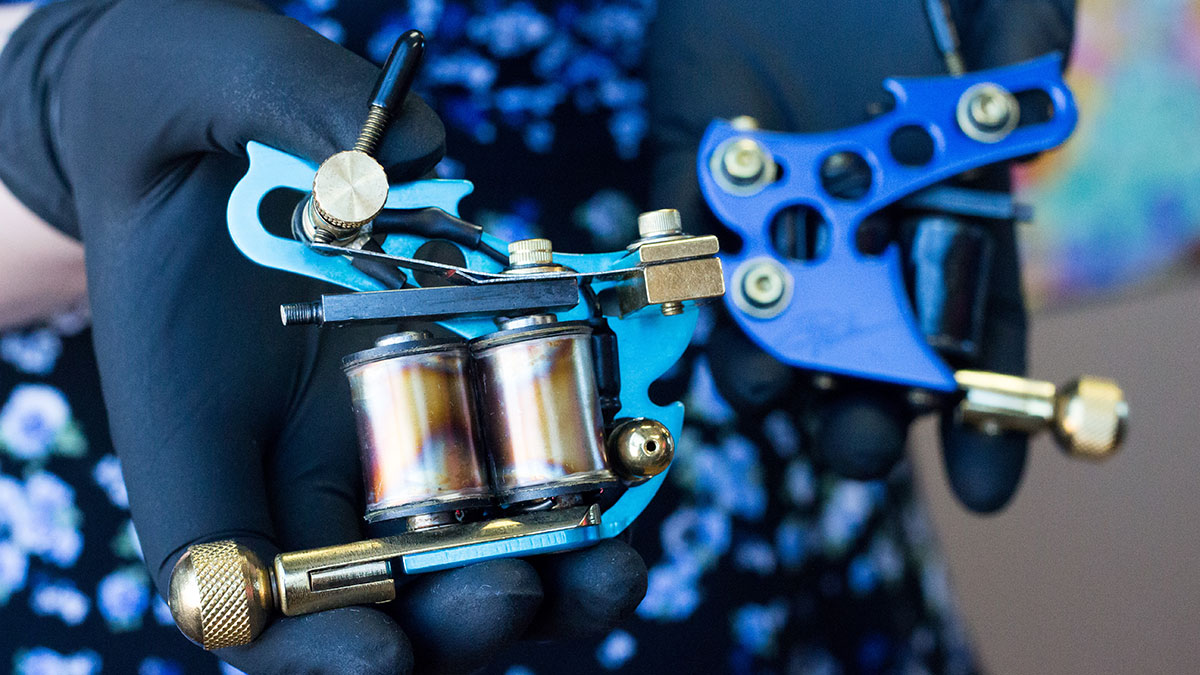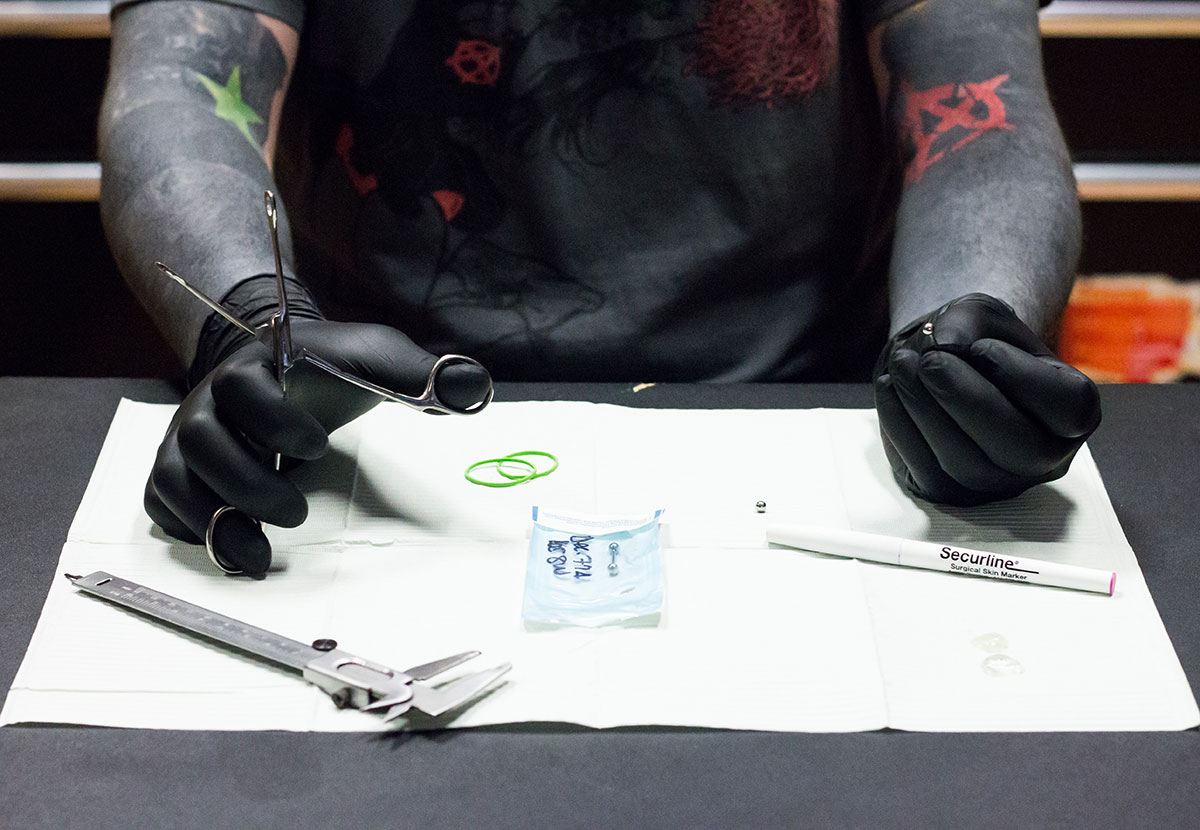Body Modification
 Spencer Nichols
Spencer NicholsGetting a tattoo or piercing can be exciting, but there’s a lot of responsibility involved as well. Before you go under the needle, you should learn what it means to have body modification done, and precautions to take so that you can have a safe and worthwhile experience with them.
What Is Body Modification?
Body modification is the deliberate altering of human anatomy or phenotype, such as, and not limited to, tattoos and body piercings.
More than just ornamental, body modification was developed long ago for various reasons including religion, medical practices, and status symbols. For instance, in Ancient Egypt, tattoos were a form of torture as well as medicine that was similar to acupuncture. Also, when nose rings were introduced to India in the 16th century, many women pierced their left nostrils, believing that spot was associated with reproductive organs and that piercing it would make childbirth easier.
After its ancient origins, which are still practiced in some areas, the next major emergent of body modification came with the punk subculture.
Punk first immerged in the 1970s and ’80s. Aside from its wicked fashion, punk subculture is best known for its anti-establishment views and the promotion of individual freedom, including the freedom to express oneself, which is where tattoos and body piercings were reintroduced.
Today, the demographic for body modification is much wider than 30 years ago. Not limited to just punks and other seemingly “scary” people, now doctors, teachers, waiters, and other professional and non-assuming individuals from various backgrounds take part in body modification.
Why have tattoos and body piercings?
Specific reasons for practicing body modification vary between people. However, Mike Slaughters and Dana Hill, self-described “punks” and owners of Pitbull Tattoos & Body Piercings on Whyte were willing to share how they were first drawn to it.
Many go to tattoos and piercings as a medium to express themselves. The freedom of being able to appear like the person you feel inside has a euphoric quality. While many modification artists and punks alike can seem like the scariest people alive, they are actually the ones that are the most self-conscious of who they are.
“We look like tough people and so on to a lot (of people),” says Slaughters. “But we’re just little kids that are scared, more or less.”
Hill confirms this as he shares how he practiced self-mutilation before discovering tattoos. He realized that tattoos were a safer and more positive way to express himself. Already an avid artist with just pencil and paper, Hill decided to apply his skills and become a tattoo artist, recreating the adrenaline he feels himself, for others.
“It grew from self-cutting into making art on myself,” he says.
Similarly, Slaughters, at a young age, felt anxiety from not feeling like he fit in with others. He received his first piercing while in high school, and immediately felt relief at being able to express himself more accurately.
With that, the two feel a sense of pride in that they are able to do for their customers what body modification has done for them. Body modification is a way to better represent themselves and who they feel they are inside.
“I feel gratified that people come in here for whatever reason and we get to do what we do to them and they leave one step closer to who they are,” Slaughters says.
How Tattoo Machines Work

Even without a sterilized tube or set of needles attached, Hill is wearing rubber gloves as he handles the machine and explains how it’s used.
In his workspace, the tattoo machine consists of two coils of wire that receive a direct current, attracting a magnetic bar above the coils. When the bar touches the coils, the connection breaks. It moves back and the magnet recharges, attracting it again, and moving at a rapid pace. Attached to the bar is a new sterilized tube and set of needles that are dipped in to capsules of dyes and pigments meant for single usage. The needles will move with the bar.
Tattooing is comparable to sewing. Like a strand of thread woven into fabric, the machine opens thin layers of skin and planting an even thinner layer of colour underneath.
How Piercings are Done

Like Hill, Slaughters immediately dons a pair of gloves before he touches any of the equipment, which is already sealed and sterilized. The procedure can be different depending on the part being pierced, but for every piercing, the area is cleaned with an alcohol solution first. The area is clamped, both to keep the marked spot still for the needle and to reduce blood flow in that area. A special needle with a plastic sheath then pierces through the spot. The needle retracts, but the tube remains long enough for the bar or stud to fit through. When the bar is in place, the tube is taken away. All of this is done in less
than a minute.
Will It Hurt?
Yes. Body modification is painful. However, everyone’s pain tolerance is different and what might be a terrible experience for one person may just feel like a pinch to someone else. You won’t know how sensitive you are until you try.
Keep in mind that some areas can hurt more than others. Generally, anything done on hard surfaces, thin skin, or places with lots of nerve endings will likely be more painful.
While getting a tattoo, keeping yourself occupied will help distract you from the worst of it. Most artists are willing to talk while they work, or you can play on your phone. The artists won’t mind as long as you stay still so that they can do their job.
Piercings are a different sensation. Some argue that it’s more painful than a tattoo, but that may depend on what you are most used to getting. It takes only seconds to get a piercing, but since the healing process is much longer, it can also be sore for longer.
Aftercare
Correct aftercare is crucial for making sure your new body mod won’t turn from a piece of art to a piece of garbage. Artists can remind you about proper treatment if you ask. At Pitbull, the piercers even give out samples of sea salt to get started on. After leaving the shop though, they are no longer responsible for how your tattoo or piercing turns out. It’s up to you to take care of it.
Tattoos
New tattoos should be bandaged up immediately before leaving the shop. The bandage should stay on for two hours at the very least, although leaving it on until the day after is more advisable. The only exception is if the artist wraps your tattoo in cellophane. In which case, you should take it off immediately. It’s better to have no bandage at all and let the skin breathe.
Once the bandage is off, the area must be cleaned. Do not submerge it in water. Do not touch it with anything abrasive, like a washcloth. With just your hand, apply lukewarm water and mild antibacterial soap. Pat the area dry with a clean towel or paper towel before applying antibacterial ointment.
After a few days, you’ll notice your tattoo will be scabbing or pealing and it might feel itchy. Do not pick at it. If it itches, slap it.
If it’s peeling, apply lotion. The scabs will eventually fall off by themselves.
Piercings
Piercings should be cleaned once a day. Cleaning your piercing multiple times a day will irritate and slow the healing process. Your hands must be completely clean before removing any stubborn crust with a cotton swab and water. After, apply a mild liquid antimicrobial/germicidal soap and water.
Avoid soaps that use Triclosan as the active ingredient. Since it’s much harsher on new skin cells, it can damage your piercing. Rinse with running water after. Unlike a new tattoo, piercings can be submerged underwater, but nothing other than the cleaning solutions should be worked into the hole.
Sea salt water soaks are one of the best methods to enhance healing and reduce irritation. Most piercers will strongly suggest a soak at least once a day. Start by dissolving a pinch of sea salt into one cup of warm or hot water, preferable distilled. You can soak the area for a few minutes, or use a cotton ball or gauze pad soaked in the solution. For oral piercings, rinse your mouth with sea salt water between meals.
Different tattoos and piercings may need more specific aftercare. Be sure to ask the people at the shop what needs to be done to make sure your body heals properly.
Dos and Don’ts for your first tattoo or piercing
Do
- Find a skilled modification artist that is confident in their craft. A tattoo and piercings licence is not necessary to work in Alberta, but a modification artist should have apprenticed at a shop before, or had a similar experience. Ask about their work history and look at their work portfolios, which can be online or/and at the shop.
- Make sure the shop is as clean as possible. Licensed shops must have annual visits from public health inspectors to insure that they are following health regulations. Ask when their last inspection was, and take note of how they sterilize their work space.
- Ask lots of questions. You want to know everything you can about your tattoo or piercing, the shop, and the artist, to make sure that your experience is as safe as possible.
Don’t
- Do it to impress someone. It’s your body. Body modification should be your choice only.
- Go to an underground or a home shop. Unlicensed shops do not have annual health inspections and they may not have professional modification artists.
- Do your own tattoo or piercing. This is just as bad as if you went to an underground shop.
- Go to an artist that refuses to follow health regulations (i.e. not wearing gloves, working in an unsanitary environment, or reusing disposable tools.) Those regulations are meant for your safety. By not following them, the client is at risk of infection and blood diseases such as HIV, Hepatitis B and C.
- Use a piercing gun. Even if it is a disposable gun, it won’t be properly sterilized like a needle will be. The blunt force can also cause excessive scar tissue, infection, shattered cartilage, and deformities.





Very informative piece. I enjoyed reading it and was impressed by the professionalism and the skill of the artists.